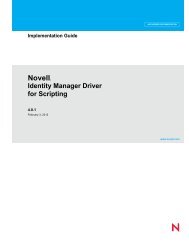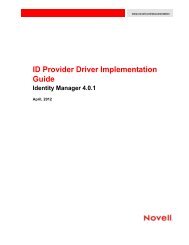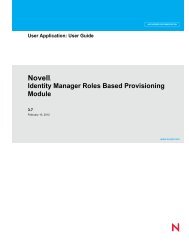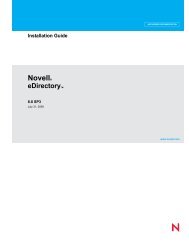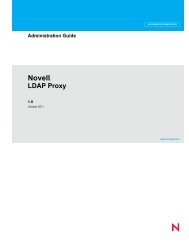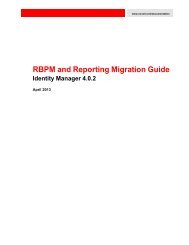Novell iManager 2.7.5 Administration Guide - NetIQ
Novell iManager 2.7.5 Administration Guide - NetIQ
Novell iManager 2.7.5 Administration Guide - NetIQ
You also want an ePaper? Increase the reach of your titles
YUMPU automatically turns print PDFs into web optimized ePapers that Google loves.
3 Save the changes and restart Tomcat.<br />
For information about restarting Tomcat, see “Starting and Stopping Tomcat” on page 94.<br />
NOTE: To modify the indexes of the NCP server objects, go to Roles and Tasks > eDirectory Maintenance<br />
> Indexes > NCP Server Object > Indexes > Modify Index Location.<br />
2.4 Access Modes<br />
When you start <strong>iManager</strong>, you are granted an access mode based on the rights youʹve been assigned.<br />
<strong>iManager</strong> has three access modes. The mode you are in is displayed on the <strong>iManager</strong> home page.<br />
Unrestricted Access: This is the default mode before RBS is configured. It displays all of the roles and<br />
tasks installed. Although all roles and tasks are visible, the authenticated user still needs the<br />
necessary rights to use the tasks.<br />
There is a setting that you can add to the config.xml file which forces Unrestricted Access, even if<br />
Role‐Based Services is installed. To force Unrestricted Access for all users, add this setting to<br />
\webapps\nps\WEB-INF\config.xml, then restart Tomcat:<br />
<br />
<br />
<br />
<br />
For information about restarting Tomcat, see “Starting and Stopping Tomcat” on page 94.<br />
NOTE: When using <strong>iManager</strong> in Unrestricted mode, you typically see the following message on the<br />
<strong>iManager</strong> Home Page: Notice: Some of the roles and tasks are not available. Clicking<br />
View Details might display a Not supported by current authenticators message for several of<br />
the tasks, even though the tasks work correctly. This message is misleading, and <strong>iManager</strong> removes<br />
these messages after you configure RBS.<br />
Assigned Access: Displays only the roles and tasks assigned to the authenticated user. This mode<br />
takes full advantage of the Role‐Based Services technology.<br />
Collection Owner: Displays all of the roles and tasks installed in the collection. If you are a collection<br />
owner, though you are not assigned specific roles, it allows you to use all the roles and tasks in the<br />
collection. Role‐Based Services must be installed in order to use this mode. Adding a group or user as<br />
a collection owner does not assign any RBS rights. To assign rights you must make explicit RBS role<br />
assignments or make trustee assignments.<br />
NOTE: When collection is assigned to a group, all the members of that group get the collection<br />
ownership. The collection owner sees all roles and tasks, regardless of role membership.<br />
2.5 Authenticating<br />
Be aware of the following issues related to <strong>iManager</strong> authentication:<br />
• Section 2.5.1, “Tree Name Field,” on page 14<br />
• Section 2.5.2, “Logging in to a Server without a Replica,” on page 14<br />
Accessing <strong>iManager</strong> 13




